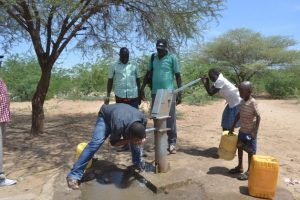NEW YORK, N.Y., March 12, 2024 (GLOBE NEWSWIRE) — The Women in the Digital Economy Fund (WiDEF), a five–year $60.5 million investment to accelerate progress on closing the global gender digital divide, announces its first call for applications with recorded remarks from the United States Agency for International Development (USAID) Administrator Samantha Power.
Founded by USAID and the Bill & Melinda Gates Foundation—and first announced by U.S. Vice President Kamala Harris in Accra, Ghana in March 2023—WiDEF will now begin identifying, funding, and accelerating investment in proven solutions to close the gender digital divide.
”The gender digital divide hinders development progress—ingraining existing inequities into the fabric of societies of the future, creating a self–perpetuating cycle that drives further disparities. We need a future in which women are empowered to participate as equal citizens in our increasingly digital world. We look forward to working together to achieve that vision,” said Samantha Power, Administrator, USAID.
“I'm proud of our support for the Women in the Digital Economy Fund. Overcoming the gender digital divide is crucial to unlock the potential of women in the digital era. By increasing women's participation in digital technology, we're aiming not just to change their status from consumers to creators and leaders; we're working to forge a path to a future where everyone benefits,” said Anita Zaidi, President of the Gender Equality Division at the Bill & Melinda Gates Foundation.
This event, which brought together leaders from across the public and private sectors and civil society worldwide, was an opportunity to celebrate the start of this effort and learn about how WiDEF will implement its ambitious vision. Representing the Biden–Harris Administration at today’s kickoff event was Rachel Vogelstein, White House Gender Policy Council Deputy Director.
Advancing access to digital technology for all women and girls is critical to achieving the United Nations’ Sustainable Development Goals. This will help ensure that everyone has access to economic opportunities and advancement as well as government services, education, and healthcare.
In low– and middle–income countries, nearly one and a half billion women lack access to online services. Through 2022, there were 259 million more men than women globally using the internet; a gap that has cost the global economy an estimated $1 trillion. Closing the gender digital divide would increase economic activity by an estimated $524 billion by 2025.
WiDEF is administered by consortium partners CARE, Global Digital Inclusion Partnership (GDIP), and the GSMA Foundation. The consortium will collaborate with industry–leading organizations to effectively engage local and global private sector actors and funders to advance a shared set of commitments to closing the gender digital divide.
“WiDEF is about putting millions of women at the center of connectivity and information programming. CARE brings our strength in locally led, gender–centered programming in over 100 countries to the effort. The consortium's collective focus on technology, policy, and gender advocacy offers the greatest opportunity yet to create and sustain an internet that works for the women who could most benefit from it,” said Revi Sterling, WiDEF Technical Director and CARE Senior Technical Director, Digital Inclusion.
“Launching WiDEF is indeed a special moment, one that reflects real commitment and determination to address the stubborn gender digital divide and open the possibilities for women in the digital economy. GDIP is committed to women's digital inclusion, and we look forward to advocating alongside our global partners to advance this collective effort,” said Sonia Jorge, GDIP Executive Director.
“Closing the gender digital divide has been at the centre of the GSMA Foundation’s work for over a decade, and we are extremely honoured to play an active role in the management of the Women in the Digital Economy Fund. We now look forward to receiving applications to the first round launched today, and to the further two rounds to be announced later this year, focused on large private sector actors, and India specifically,” said Max Cuvellier Giacomelli, Head of Mobile for Development, GSMA.
WiDEF will support and fund programs that advance digital access and affordability; develop relevant products and tools; provide digital literacy and skills training; promote online safety and security; and invest in sex–disaggregated data and research. It will support, wherever possible, women–led and gender transformative solutions, products, and tools and will invest heavily in ensuring the voices and institutions closest to the gender digital divide are central to the effort.
As part of today’s event, WiDEF announced the first call for applications, inviting local institutions worldwide to apply to receive WiDEF funding and support. Applications are due by May 6, 2024.
In addition to financial support from USAID and the Bill & Melinda Gates Foundation, funding is also being provided by Microsoft and the Korean International Cooperation Agency.
To learn more, email contact@widef.global, visit us online at widef.global or follow WiDEF on social media (Instagram, Facebook, LinkedIn and Twitter/X).
About CARE
Founded in 1945 with the creation of the CARE Package®, CARE is a leading humanitarian organization fighting global poverty. CARE places special focus on working alongside women and girls. Equipped with the proper resources, women and girls have the power to lift whole families and entire communities out of poverty. This year, CARE and partners worked in 109 countries implementing 1,671 poverty–fighting development and humanitarian aid projects and initiatives that reached 167,000,000 people. To learn more, visit www.care.org.
About GDIP
The Global Digital Inclusion Partnership (GDIP) is a coalition of public, private, and civil society organizations working to bring internet connectivity to the global majority and ensure everyone is meaningfully connected by 2030. Founded by a global team of experts who successfully championed affordable and meaningful connectivity around the world, GDIP advances digital opportunities to empower and support people’s lives and agency, leading to inclusive digital societies.
GSMA Mobile for Development Foundation
The GSMA Mobile for Development Foundation, Inc. (‘The GSMA Foundation’) brings together mobile operators, innovators, governments, and the international development community to realise the positive social, economic and climate impact of mobile technology, primarily in low– and middle–income countries. With funding from donors and the GSMA, the GSMA Foundation runs programmes that advance digital and financial inclusion – with a strong focus on gender inclusivity, climate action, humanitarian response, and investment in innovative digital solutions. Since 2007, these programmes have impacted the lives of over 220 million people.

GLOBENEWSWIRE (Distribution ID 9062253)










